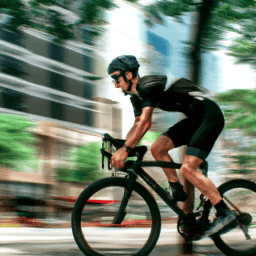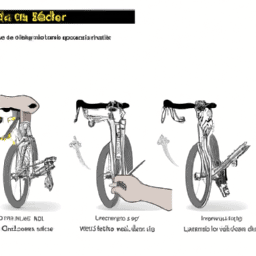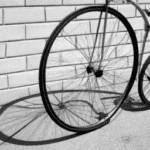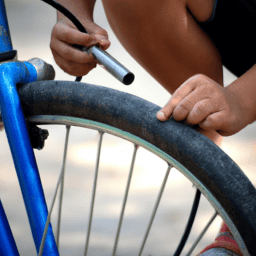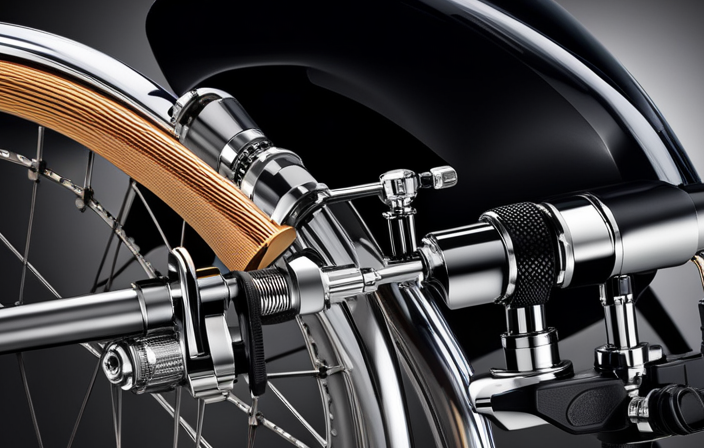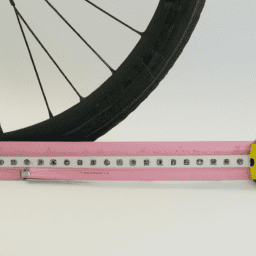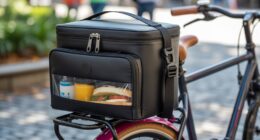Cycling offers an exhilarating sensation, providing a feeling of liberation and strength. When I’m biking down the path, I merge with the bicycle, and my physical and mental efforts synchronize flawlessly towards a singular objective: velocity.
How fast can a bicycle go, you may ask? Well, that’s a question that has fascinated me for years, and it’s a topic that I’m excited to explore in this article.
To me, the bicycle is more than just a mode of transportation; it’s a symbol of human ingenuity and determination. From the early days of cycling to the modern era of high-tech bikes and gear, we have pushed the limits of what’s possible, constantly striving to go faster, farther, and higher.
Whether you’re a professional cyclist, a weekend warrior, or a casual commuter, understanding the factors that affect bicycle speed and the techniques to increase it can help you achieve your cycling goals and enjoy the thrill of the ride at its fullest.
So, let’s dive into the world of high-speed cycling and see how fast we can go!
Key Takeaways
- Factors such as pedaling efficiency and terrain gradient affect bicycle speed.
- Techniques like proper gear selection and aerodynamic positioning can increase bicycle speed.
- High-speed cycling can be a practical means of commuting and provide an exhilarating experience for adventure seekers.
- The fastest recorded velocity achieved on a bike is over 180 kilometers per hour in competitive cycling.
Factors That Affect Bicycle Speed
You’ll want to pay attention to factors like wind resistance and road surface if you want to increase your bike speed. Pedal efficiency is the first factor that affects how fast your bike can go. This refers to how much power you can generate with each pedal stroke. The more efficient you are at pedaling, the faster you can go. This can be improved through training and proper gear selection.
The second factor is terrain gradient. This refers to the steepness of the road you’re riding on. The steeper the road, the slower you’ll go. However, with proper training and gearing, you can still maintain a decent speed on steep roads.
These are just two of the many factors that can affect your bike speed, so it’s important to pay attention to all of them. Now, let’s take a look at some of the fastest recorded bicycle speeds.
The Fastest Recorded Bicycle Speeds
Remarkably, the top recorded velocity achieved on a bike is over 180 kilometers per hour. This record was set by a Dutch cyclist named Fred Rompelberg in 1995. Rompelberg achieved this unbelievable speed by drafting behind a Porsche 911 and utilizing aerodynamic advancements such as a special bike frame and clothing.
Since then, other cyclists have attempted to break Rompelberg’s record, but none have been able to surpass his remarkable speed. However, with continued advancements in technology and aerodynamics, it’s possible that someone will eventually break this record.
In the next section, I’ll discuss some techniques that can be used to increase bicycle speed.
Techniques to Increase Bicycle Speed
Want to know how to boost your bike’s speed? There are several techniques you can try to increase your velocity on two wheels. One of the most important factors is pedaling efficiency. This means making the most of each stroke by using the right gear, maintaining a consistent cadence, and avoiding unnecessary movement. A smooth and efficient pedal stroke can make a huge difference in your speed and endurance.
Another key factor is aerodynamic positioning. This involves finding the optimal position on your bike to reduce wind resistance and increase speed. Some common techniques include tucking your elbows in, lowering your head and chest, and positioning your body to angle into the wind. By reducing wind resistance, you can increase your speed without expending as much energy.
When it comes to increasing your bike’s speed, pedaling efficiency and aerodynamic positioning are just two of many techniques you can try. However, it’s important to keep in mind that cycling at high speeds also comes with certain safety considerations. In the next section, we’ll explore some tips and strategies for staying safe while cycling at high speeds.
Safety Considerations When Cycling at High Speeds
As a cyclist who enjoys riding at high speeds, I’m aware of the importance of safety considerations when cycling at such speeds.
Firstly, protective gear is crucial to minimize the risk of injuries in case of a fall or collision.
Secondly, being aware of my surroundings is essential to anticipate potential hazards and react accordingly.
Lastly, adhering to traffic laws is not only a legal requirement but also a way to ensure my safety and that of others sharing the road with me.
Protective Gear
You gotta suit up like a superhero if you wanna survive a high-speed wipeout on a bicycle. Protective gear is a crucial aspect of cycling, especially when it comes to going at high speeds.
A helmet is the most important piece of gear, as it protects your head from serious injury. In the event of a crash, a helmet can mean the difference between life and death. It’s important to make sure your helmet fits properly and is securely fastened before every ride.
Gloves are another important piece of protective gear. They provide additional grip on the handlebars, which can be essential when going at high speeds. They also protect your hands in case of a fall, preventing injury and road rash. When choosing gloves, make sure they fit snugly but comfortably and allow for ease of movement.
Remember, safety should always come first when it comes to cycling at high speeds. With the right protective gear, you’ll be better prepared for any potential accidents and can enjoy your ride with peace of mind.
To stay safe while cycling at high speeds, it’s also important to be aware of your surroundings. This means paying attention to other cyclists, pedestrians, and vehicles on the road. By being aware of your surroundings, you can react quickly to unexpected situations and avoid potential collisions.
Always keep your eyes up and scan the road ahead, looking for potential hazards. With the right protective gear and awareness of your surroundings, you can enjoy the thrill of cycling at high speeds while staying safe and avoiding accidents.
Awareness of Surroundings
Hey, buddy, keeping an eye on your surroundings is crucial while cycling at high speeds to avoid any potential accidents.
Road hazards can be a menace to bikers, and situational awareness is key to ensuring that one steers clear of them. For instance, potholes, debris, and wet surfaces can cause a cyclist to lose control and potentially suffer injuries. Therefore, it’s essential to scan the road ahead for any hazards and adjust your speed and direction accordingly.
Additionally, it’s essential to be aware of other road users, such as cars, pedestrians, and other cyclists. Always assume that drivers may not see you, and be cautious when approaching intersections and crosswalks. Use hand signals to indicate your intentions, and make eye contact with drivers to ensure that they have seen you.
Remember, while cycling at high speeds, a split-second decision can be the difference between a safe ride and a catastrophic accident. So, always keep your head on a swivel and be aware of your surroundings.
Adhering to traffic laws is the next step in ensuring a safe and enjoyable cycling experience.
Adhering to Traffic Laws
To ensure a safe ride, it’s crucial that you follow traffic laws while cycling, even if it means waiting at a red light for what feels like an eternity.
One of the most important aspects of adhering to traffic laws is signaling. Proper signaling, whether it’s using hand signals or bike-mounted indicators, can communicate your intentions to other road users and prevent accidents. Failing to signal can cause confusion and increase the risk of collisions, especially when turning or changing lanes.
Not following traffic laws can have serious consequences, both for yourself and others. Running a red light or stop sign, for example, can result in a collision with a vehicle or pedestrian, potentially causing severe injuries or even death.
In addition to the physical risks, breaking traffic laws can also result in legal consequences, such as fines or even criminal charges. By following traffic laws, you not only reduce the risk of accidents but also set a good example for other cyclists and motorists on the road.
With this in mind, let’s now explore practical applications of high-speed cycling.
Practical Applications of High-Speed Cycling
As a cycling enthusiast, I’ve explored the practical applications of high-speed cycling in various contexts.
Competitive cycling is a popular sport that demands both speed and endurance, and it requires specialized equipment and training.
High-speed cycling can also be a practical means of commuting in urban areas, offering a fast and eco-friendly alternative to cars.
Additionally, leisure cycling at high speeds can provide an exhilarating experience for those seeking adventure and adrenaline.
Competitive Cycling
If you’re looking to push your limits and compete, you’ll be amazed at how fast a bicycle can go in the world of competitive cycling.
In order to achieve these incredible speeds, cyclists must follow a rigorous training regimen and maintain a strict nutrition plan. The physical demands of competitive cycling are immense and require both mental and physical strength.
In addition to the physical demands, competitive cycling also requires a deep understanding of strategy and tactics. Cyclists must be able to read the race and make split-second decisions in order to gain an advantage over their competitors.
If you’re looking for an exciting and challenging sport, competitive cycling may be just what you’re looking for. But if you’re simply looking for a way to get around town, commuting by bicycle is a great option that offers many benefits.
Commuting
Commuting by bike offers a plethora of benefits, from cutting down on transportation costs to improving overall fitness levels and reducing carbon emissions. As a frequent bike commuter, I’ve witnessed firsthand the convenience and efficiency of biking as a mode of transportation.
With the increasing availability of bike lanes and infrastructure in cities, it’s become easier and safer to commute by bike.
One of the biggest challenges of bike commuting can be the logistics of transportation. Many people may not have the space to store a full-sized bike at their workplace or may need to take public transportation part of the way. This is where folding bikes come in handy. These compact bicycles can easily be stored under a desk or in a closet, and can be carried onto buses or trains without any additional fees. Plus, with advances in technology, folding bikes are becoming more lightweight and durable, making them a viable option for daily commuting.
When it comes to leisure cycling, the focus shifts from efficiency to enjoyment.
Leisure Cycling
For a relaxing ride, nothing beats cruising along the beach on a laid-back cruiser bike. Leisure cycling is all about enjoying the journey and taking in the beautiful scenery along the way.
Whether you’re looking for a peaceful ride through the countryside or a scenic route through the city, there are plenty of options available for cyclists of all skill levels. Here are some of the best cycling routes and scenic destinations for leisure cyclists:
- The Golden Gate Bridge in San Francisco, California
- The Katy Trail in Missouri
- The Napa Valley Vine Trail in California
- The Great Allegheny Passage in Pennsylvania and Maryland
These routes offer breathtaking views and a chance to explore some of the most beautiful parts of the country on two wheels. So, grab your bike and hit the road to experience the joy of leisure cycling.
Frequently Asked Questions
What is the world record for the longest distance traveled on a bicycle in 24 hours?
I once read about a cycling legend who covered 541 miles in 24 hours. Impressive, right? Such a feat requires meticulous training techniques and strict nutritional requirements. It’s a testament to the human spirit and the power of endurance.
How does wind resistance affect bicycle speed?
Wind resistance, influenced by aerodynamics and physics, can significantly impact bicycle speed. Rider position, such as tucking in, can reduce drag. Understanding and managing wind resistance is vital for maximizing performance.
Can the type of tires used on a bicycle affect its speed?
Tubeless tires have lower rolling resistance than clincher tires, making them faster. Proper tire pressure is also crucial for speed. The right tire choice and pressure can help me fly down the road.
What is the most common mistake that cyclists make when trying to increase their speed?
The most common mistake I’ve seen cyclists make when trying to increase their speed is neglecting proper technique and relying solely on training methods. It’s important to focus on form, posture, and efficient pedal strokes to maximize speed potential.
Are there any health risks associated with cycling at high speeds for extended periods of time?
Cycling at high speeds for extended periods of time can lead to increased heart rate and muscle fatigue. These factors increase the risk of injury and overuse. It is important to balance intensity and rest to avoid these health risks.
Conclusion
In conclusion, the speed of a bicycle is influenced by various factors, including the rider’s power output, the terrain, and the aerodynamics of the bicycle. To achieve the fastest speeds, techniques such as drafting and optimizing body position can be utilized. However, it’s crucial to prioritize safety when cycling at high speeds, wearing appropriate equipment, and following traffic laws.
In many ways, the pursuit of high-speed cycling is akin to the quest for knowledge. Just as a cyclist must carefully consider their approach to achieve optimal speed, a scholar must analyze and synthesize information to reach intellectual breakthroughs. Both require a combination of skill, technique, and determination.
And just as a cyclist must constantly adapt to changing conditions on the road, a scholar must remain open to new ideas and perspectives. Ultimately, the pursuit of speed and knowledge is a never-ending journey, but one that rewards those who’re willing to put in the effort and push themselves to new heights.
